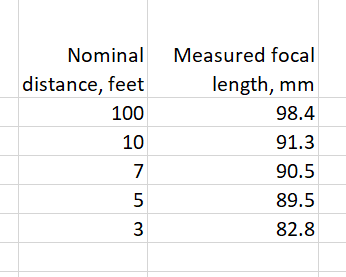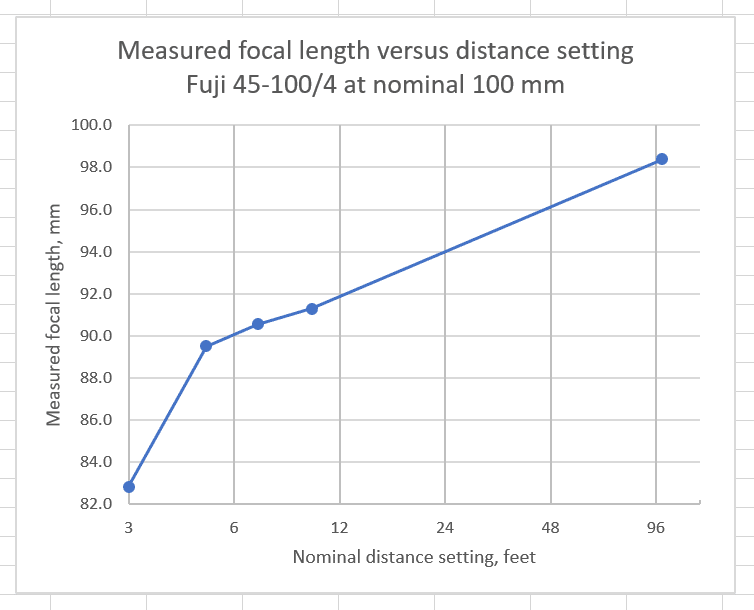In my last post, I did a quick-and-dirty calculation of the focal length of the Fuji 45-100 mm f/4 G-mount lens when the nominal focal length was set to 100 mm. I got about 80 mm at 3 feet. There is an accurate method of measuring the focal length of lenses that was, if not invented by, at least popularized by Bill Claff. He tells you how to do it here. All you need is two extension tubes of different lengths and a ruler. I used the Fuji 45mm and 18mm tubes. With those tubes, the focal length is given by the formula:
f = 27 / (m1 – m2)
where m1 is the measured magnification with the 45 mm tube, and m2 is the measured magnification with the 18 mm tube, and the focal length is measured in mm.
Here’s what I got:
In graphical form, that looks like:
So I wasn’t that far off. Some of you have asked about the focal length at portrait distances. You can see those in the above table and graph.


Thanks, Jim! And the formula used by Bill is so beautiful that I cannot stop myself from commenting on it! So:
Just think about about imaging a 1 cm-high object “I” with its bottom on the optical axis:
↑
I
‾‾‾‾‾‾‾‾‾‾‾‾‾‾‾‾‾‾‾‾‾‾‾‾‾‾‾‾‾‾‾‾‾‾‾‾‾‾‾‾‾‾‾‾‾‾‾‾‾‾‾‾‾‾‾‾‾‾‾‾
↓
(here ↕ is the lens). The critical observation is that if we know the plane where the image of “I” is focused, to find the size of the image it is enough to know where ONE light ray from the top of “I” crosses this plane. (This is the DEFINITION of being in focus!)
The “Bill’s” trick is to take the HORIZONTAL light ray going from the top of “I”. CONCLUSION: the behavior of this ray does not depend on the distance of “I” from the lens! (It is a horizontal ray 1cm away from the optical axis.) By definition, after passing the lens, this ray passes through the focal point of the lens with the slope 1cm/ƒ.
⇒ formula: magnfiication = d/ƒ,
here d is the distance between the focal point of the lens and the focus plane of “I”. Wonderful formula — I did not realize that!
I see that your white-space stripping code is more aggressive than I thought… Trying to correct the picture:
↑
I
‾‾‾‾‾‾‾‾‾‾‾‾‾‾‾‾‾‾‾‾‾‾‾‾‾‾‾‾‾‾‾‾‾‾‾‾‾‾‾‾‾‾‾‾‾‾‾‾‾‾‾‾‾‾‾‾‾‾‾‾
↓
Are you speaking about paraxial focal length here?
Usually, when photographers complain about FL, they mean field of view, not focal length.
I am sure that some people two don’t understand difference well will read this… and spread confusion further.
I’m talking about plain old focal length. The focal length that I’m talking about definitely affects field of view.